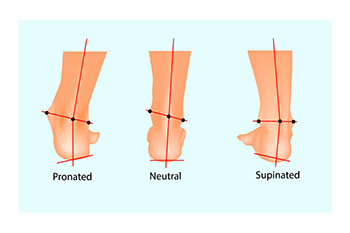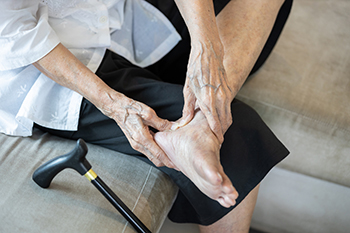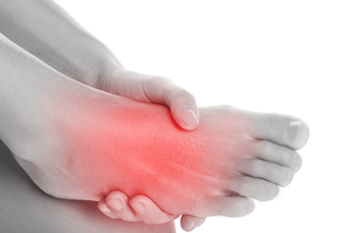Garner (919) 661-4150
Garner (919) 661-4150

A sprained foot occurs when connective tissues, such as ligaments and cartilage in the foot's joints, are damaged or torn. Sprains often result from sudden twists or impacts. This can happen during activities, including stepping on uneven surfaces or engaging in vigorous sports like ballet or gymnastics. Symptoms of foot sprains include pain that becomes more severe from pressure, limited mobility, and visible signs like bruising and swelling. The severity of foot sprains ranges from mild to severe, necessitating an assessment from a podiatrist. This foot doctor conducts physical examinations and imaging tests to confirm the type and severity of the injury and assess its extent. Treatment typically involves rest and elevation to reduce inflammation. In severe cases, splinting or surgery may be necessary. If you believe you have sprained your foot, it is suggested that you schedule an immediate appointment with a podiatrist for an accurate diagnosis, tailored treatment plans, and comprehensive support.
Foot and ankle trauma is common among athletes and the elderly. If you have concerns that you may have experienced trauma to the foot and ankle, consult with Chukwuma Ukata, DPM from Advanced Carolina Foot and Ankle Center. Our doctor will assess your condition and provide you with quality foot and ankle treatment.
Foot and ankle trauma cover a range of injuries all over the foot; common injuries include:
Symptoms
Symptoms of foot and ankle injuries vary depending on the injury, but more common ones include:
Diagnosis
To properly diagnose the exact type of injury, podiatrists will conduct a number of different tests. Some of these include sensation and visual tests, X-rays, and MRIs. Medical and family histories will also be taken into account.
Treatment
Once the injury has been diagnosed, the podiatrist can than offer the best treatment options for you. In less severe cases, rest and keeping pressure off the foot may be all that’s necessary. Orthotics, such as a specially made shoes, or immobilization devices, like splints or casts, may be deemed necessary. Finally, if the injury is severe enough, surgery may be necessary.
If you have any questions, please feel free to contact our office located in Garner, NC . We offer the newest diagnostic and treatment technologies for all your foot care needs.

Understanding supination, also called underpronation, is essential for maintaining foot health. Supination occurs when your weight rolls onto the outer edges of the feet during movement. It is often the result of inherited structural issues or muscle weakness. Unfortunately, excessive supination can lead to various problems, including back and hip pain, knee stress, ankle injuries, and plantar fasciitis. Supination can also cause tension in different parts of the body over time, increasing the risk of injuries. Seeking medical help from a podiatrist for a gait analysis is advisable if you suspect supination, or are experiencing unexplained lower body pain. Treatment typically involves corrective measures to address foot alignment and prevent future injuries. This may include selecting appropriate footwear with extra cushioning and room in the toes, using custom-made orthotic insoles, and performing strength and stretching exercises as suggested by a podiatrist. Proper care and intervention can alleviate discomfort and prevent complications associated with supination, ensuring optimal mobility and well-being. If you believe you have pain that results from supination, it is suggested that you schedule an appointment with a podiatrist.
If you have any concerns about your feet, contact Chukwuma Ukata, DPM from Advanced Carolina Foot and Ankle Center. Our doctor can provide the care you need to keep you pain-free and on your feet.
Biomechanics in Podiatry
Podiatric biomechanics is a particular sector of specialty podiatry with licensed practitioners who are trained to diagnose and treat conditions affecting the foot, ankle and lower leg. Biomechanics deals with the forces that act against the body, causing an interference with the biological structures. It focuses on the movement of the ankle, the foot and the forces that interact with them.
A History of Biomechanics
Modern technological improvements are based on past theories and therapeutic processes that provide a better understanding of podiatric concepts for biomechanics. Computers can provide accurate information about the forces and patterns of the feet and lower legs.
Understanding biomechanics of the feet can help improve and eliminate pain, stopping further stress to the foot.
If you have any questions please feel free to contact our office located in Garner, NC . We offer the newest diagnostic and treatment technologies for all your foot and ankle needs.

Proper foot care is of extreme importance for diabetics to prevent serious complications, such as foot ulcers and possibly gangrene. A daily regimen begins with checking your feet daily for cuts, redness, swelling and sores, or any skin or nail changes. Use a mirror or ask for help if needed. Wash your feet daily with warm water, ensuring thorough drying and moisturizing except between toes. Always wear well-fitting shoes and socks or slippers to protect against injury, and inspect shoes regularly. Trim toenails straight across and seek podiatric assistance if necessary. Avoid self-treating corns or calluses. Schedule regular foot exams with a podiatrist, especially if you have nerve damage, to monitor sensation and blood flow. Promote circulation by elevating feet when sitting and incorporating gentle exercises. Choose low-impact activities like walking, biking, or swimming. It is suggested that people with diabetes schedule regular visits to a podiatrist to prevent or manage the serious complications caused by this disease.
Diabetic foot care is important in preventing foot ailments such as ulcers. If you are suffering from diabetes or have any other concerns about your feet, contact Chukwuma Ukata, DPM from Advanced Carolina Foot and Ankle Center. Our doctor can provide the care you need to keep you pain-free and on your feet.
Diabetic Foot Care
Diabetes affects millions of people every year. The condition can damage blood vessels in many parts of the body, especially the feet. Because of this, taking care of your feet is essential if you have diabetes, and having a podiatrist help monitor your foot health is highly recommended.
The Importance of Caring for Your Feet
Patients with diabetes should have their doctor monitor their blood levels, as blood sugar levels play such a huge role in diabetic care. Monitoring these levels on a regular basis is highly advised.
It is always best to inform your healthcare professional of any concerns you may have regarding your feet, especially for diabetic patients. Early treatment and routine foot examinations are keys to maintaining proper health, especially because severe complications can arise if proper treatment is not applied.
If you have any questions please feel free to contact our office located in Garner, NC . We offer the newest diagnostic and treatment technologies for all your foot and ankle needs.

Foot tendon pain, often termed tendonitis, can arise from various causes. Tendons are essential for foot function because they connect muscles to the foot's many bones and support daily activities like walking and running. Common causes of foot tendon injury include wearing ill-fitting footwear, sudden foot movements, repetitive stress from activities like sports, and trauma. Structural issues, such as flat feet or high arches, can predispose individuals to tendon problems. Age-related degeneration and medical conditions, like diabetes and rheumatoid arthritis, are other contributing factors to foot tendon pain. Obesity increases the risk of tendonitis due to increased pressure on the feet. Also, overuse, weak muscles, and loose ligaments can contribute. Understanding these factors helps individuals to take proactive steps to safeguard their foot health. If you are experiencing persistent foot tendon pain or discomfort, it is suggested that you schedule an appointment with a podiatrist for a comprehensive evaluation and diagnosis, followed by a personalized treatment plan.
Foot Pain
Foot pain can be extremely painful and debilitating. If you have a foot pain, consult with Chukwuma Ukata, DPM from Advanced Carolina Foot and Ankle Center. Our doctor will assess your condition and provide you with quality foot and ankle treatment.
Causes
Foot pain is a very broad condition that could be caused by one or more ailments. The most common include:
Diagnosis
To figure out the cause of foot pain, podiatrists utilize several different methods. This can range from simple visual inspections and sensation tests to X-rays and MRI scans. Prior medical history, family medical history, and any recent physical traumatic events will all be taken into consideration for a proper diagnosis.
Treatment
Treatment depends upon the cause of the foot pain. Whether it is resting, staying off the foot, or having surgery; podiatrists have a number of treatment options available for foot pain.
If you have any questions, please feel free to contact our office located in Garner, NC . We offer the newest diagnostic and treatment technologies for all your foot care needs.

Foot and toe fractures, encompass diverse types, each presenting unique characteristics and considerations for treatment. Spiral fractures, often seen in sports injuries or severe trauma, involve a twisting force that causes the bone to break in a spiral pattern along its length. Internal metatarsal fractures occur within the long bones of the foot, typically resulting from direct impact or excessive stress. These fractures may affect multiple metatarsals and often require careful assessment to detect subtle injuries. Fifth metatarsal fractures, known as Jones fractures, occur at the base of the fifth metatarsal, typically due to sudden twisting motions or overuse. These fractures can be challenging to heal due to limited blood supply in the area. Prompt diagnosis and appropriate treatment, including immobilization, rest, and possibly surgical intervention, are essential for optimal recovery and prevention of long-term complications. If you have fractured your toe or foot bones, it is suggested that you speak with a podiatrist who can offer the correct treatment for the type of fracture you have.
A broken foot requires immediate medical attention and treatment. If you need your feet checked, contact Chukwuma Ukata, DPM from Advanced Carolina Foot and Ankle Center. Our doctor can provide the care you need to keep you pain-free and on your feet.
Broken Foot Causes, Symptoms, and Treatment
A broken foot is caused by one of the bones in the foot typically breaking when bended, crushed, or stretched beyond its natural capabilities. Usually the location of the fracture indicates how the break occurred, whether it was through an object, fall, or any other type of injury.
Common Symptoms of Broken Feet:
Those that suspect they have a broken foot shoot seek urgent medical attention where a medical professional could diagnose the severity.
Treatment for broken bones varies depending on the cause, severity and location. Some will require the use of splints, casts or crutches while others could even involve surgery to repair the broken bones. Personal care includes the use of ice and keeping the foot stabilized and elevated.
If you have any questions please feel free to contact our office located in Garner, NC . We offer the newest diagnostic and treatment technologies for all your foot and ankle needs.